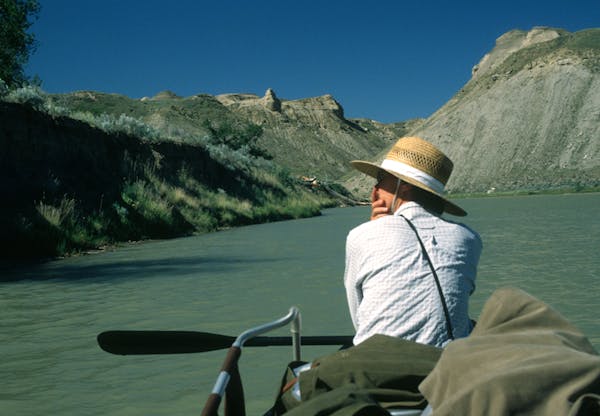In a decision that could significantly affect Wisconsin deer hunting — where last year more than 16,000 Minnesotans chased whitetails — a federal court this week ruled that Chippewa Indians in northern Wisconsin can hunt deer at night with high-powered rifles.
Perhaps as many as 200 Chippewa hunters will be in the woods and fields of northern Wisconsin beginning Nov. 1, three weeks before the beginning of the state's nine-day firearms whitetail season.
The Chippewa's nighttime season will continue until the first Monday in January, with a break during the state-regulated firearms deer season.
No limit will be placed on the number of deer a Chippewa hunter may kill, said Colette Routel, a William Mitchell College of Law professor and lead attorney for the six Wisconsin Chippewa bands that sought the nighttime hunt.
Hunting at night with torches is a Chippewa tradition dating to pre-settlement, Routel said.
The six bands are signatories to an 1837 treaty that ceded a large section of northern Wisconsin and all or portions of 12 east-central Minnesota counties to the federal government.
Court rulings spanning at least three decades have affirmed that the Chippewa reserved off-reservation hunting, fishing and gathering rights in the ceded territory.
The Wisconsin Chippewa most recently renewed their court fight for nighttime deer hunting in 2012, after the Wisconsin Legislature approved a state-regulated wolf-hunting season that included nighttime hunting. (The nighttime wolf hunting provision was later rescinded.)
Until then, the Wisconsin resource agency had prevailed in court against the Chippewa, arguing that night deer hunting posed a public safety threat.
"Wolf hunting wasn't the only nighttime hunting that had occurred in Wisconsin, sanctioned by the DNR,'' Routel said Thursday. "The DNR itself, or through its contractors, had shot and killed deer at night to reduce the threat of spreading CWD [chronic wasting disease].
"The state argued these [night hunts] weren't similar to what the Chippewa were seeking. But we felt any safety risks were the same. So why was the state allowing some people to shoot wolves or deer at night but not the Chippewa?''
Unlike most state-regulated sportsmen and women, who usually hunt for themselves and their immediate families, the Chippewa, Routel said, are expected to put a limited number of hunters in the field at night to shoot multiple deer for distribution among band members.
Tribal officials had argued before senior U.S. District Judge Barbara Crabb in Madison that the rules they will impose on Indian night hunters reduce any safety risk to negligible.
Indian hunters must, for example, demonstrate to tribal officials that they will be hunting from a stationary position and must present a diagram identifying the likely direction of gunfire from that position.
A sufficient earthen backstop also must be identified within 125 yards of the hunter's position. A spotlight bright enough to reach the backstop also must be used.
Chippewa night hunters also must pass a marksmanship test, and they won't be allowed to shoot from roads or vehicles unless they are disabled.
"The number of deer that tribal members have taken in the past [while daytime hunting off-reservation in the ceded territory] has represented only about 1 percent of the total harvest for the region,'' Routel said.
"I think the addition of night hunting will produce a significant increase in harvest for the tribes but add very little to their share of their region's overall harvest.''
Originally, the bands wanted the night hunt to begin Oct. 15. The DNR preferred the end of November, after the nine-day state-regulated firearms season.
"The tribes settled on November 1 because that's the beginning of the rut, or mating season for deer, meaning they are more vulnerable then to being harvested,'' Routel said.
Most of Wisconsin's more than 600,000 deer hunters are well aware when the peak of the rut occurs. And they have long supported starting their firearms season well after the rut has largely ended, in part to conduct it when deer are less vulnerable than they would otherwise be.
Meanwhile, Fond du Lac Chippewa band officials in Minnesota are reviewing the court decision. Along with Minnesota's Mille Lacs band, Fond du Lac signed the 1837 treaty.
"I just found out about the court ruling,'' said Mike Schrage, Fond du Lac wildlife biologist. "Night hunting is not an issue that has come up very much with us. We'll have to figure it out.''
danderson@startribune.com

Anderson: Celebrate Earth Day by rekindling real connection to nature
Anderson: Anglers protesting tough new Mille Lacs rules are wrong

Anderson: Courts, not politicians, should rule on Red Lake, White Earth lands

Anderson: Multimillion windfall gets invasive carp deterrent moving
![A young whitetail deer searches for food as another blanket of snow coats the arrowhead. ] Minnesota -State of Wonders, Arrowhead in Winter BRIAN PETE](https://arc.stimg.co/startribunemedia/WK32UWWY6FKNWJUIYCJ6ZPT4AU.jpg?h=91&w=145&fit=crop&bg=999&crop=faces)

